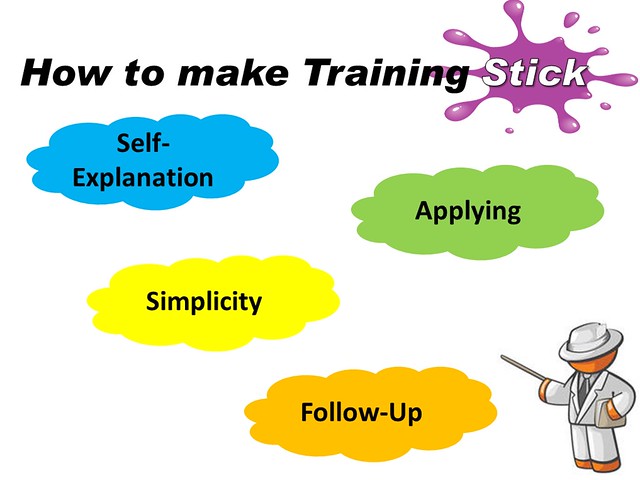How To Make Training Stick
How To Make Training Stick
by Ivan Teh RunningMan
It's one of the biggest questions in the continuing education and training industry, and one of the issues that adult / andragogy trainers struggle with on a daily basis. by Ivan Teh RunningMan
How do we ensure that training truely sticks, that learners retain and carry over the skills and knowledge learnt to the workplace, and actually apply what they've learnt, even after a lengthly period of time?
Asked by everyone from managers to trainers, and even the leaners themselves, the search for this answer has lead to countless studies and research, ranging from the behaviour of your brain, to 'tricks' trainers use during facilitation.
In my initial research into How To Make Training Stick, I've decided to focus on 4 ways:
1. Self-Explanation
2. Applying
3. Simplicity
4. Follow-Up
 |
| How To Make Training Stick |
Each of these 4 ways to make training stick encompass several steps that trainers or learners can perform to increase the likelihood of training being retained and transferred, thus increasing its effectiveness.
.....
1. Self-Explanation
 |
Self-Explanation is when the learners attempt to explain what they learnt. This aids in memory retention, because coming to an internal realisation, or an 'A-Ha!' moment, makes the learning much more meaningful, not to mention the small sense of accomplishment that accompanies it. This makes Self-Explanation much more effective than simply 'telling' or 'lecturing' learners, which mainly affects the short term memory.
As trainers, we should try to facilitate our learners to come to that internal realisation with Self-Explanation, by asking targeted questions about the key learning points of a topic. Furthermore, the ability to recall, relate and contextualize the training for learners also aids retention, as learners will find it more relevant and useful.
Self-Explanation can take various forms, as long as it requires the learners to process what was learnt in their minds, such as verbally answering questions in their own words / paraphrasing, or taking notes.
Methods of Self-Explanation:
- Answering Questions
- Taking Notes
- Paraphrasing / Putting It In Their Own Words
- Silent Thinking
- Self-Study
2. Applying
 |
Practice makes perfect, and this is true when it comes to Applying. Being able to show application / apply what was learnt is a basic standard to show competence in learning. Applying is useful because it allows learners the opportunity to exercise and practice their learning in a controlled, non judgemental environment, where making mistakes is part of the learning process and not a life-and-death situation.
As trainers, we should allow for ample Applying opprtunities for learners, in various forms. Applying also aids leaners to contextualize the learning, and demonstrate the relevance in a real world context. Furthermore, repeated use of Applying in learning allows learners to build confidence and in the long term, good habits.
Applying can take various forms, the most common of which is testing (multiple choice, short answers, essay, demonstrations), group discussions, case studies, brainstorming, mindmapping, and role plays. Some lesser used, but still useful Applying techniques include ranking of information, telling stories, debating both sides of a topic, and teaching others (the best way to learn).
Methods of Applying:
- Testing - Quizzes, Multiple Choice Questions, Short Answer Questions, Essays, Demonstrations, Presentations
- Case Studies
- Group Discussions
- Role Plays
- Brainstorming
- Mindmapping
- Ranking
- Story Telling
- Debates
- Reviewing Videos
3. Simplicity
 |
Simplicity is all about breaking complicated or large chunks or information into smaller, more manageable sizes, and presenting it in a logical, yet uncomplicated manner, using visuals and appropriate pacing. The human brain is unable to absorb large or unwieldy sets of information, and is prone to discarding information, or 'tuning out' when presented with this.
From a learner's perspective, effort will be required to properly process and sort the information received. Thus, Simplicity aids not only in understanding, but also in communicating the information, and preventing misunderstanding. Simplicity is also useful for planning and presenting information in small, logical chunks, building on the knowledge that came before.
Trainers can achieve Simplicity by using visuals in presentation, step by step instructions, and pacing the delivery of information such that 1 learning point can be covered within 10 - 20 minutes. After each learning point, have the learners practise Applying or Self-Explanation.
Methods of Simplicity:
- Leveraging On Current Technology
- Including More Visuals
- Step By Step Instructions
- Infographics - Flow Charts, Graphs, Pie Charts, Bar Charts
- Pacing / Spacing Out Content
- Logical Flow Of Content / Building On Prior Knowledge
- Repetition
- Showing Relevance / Contextualise / Relating
- Short Chunks / Bite Sized Content
- Emphasis
4. Follow-Up
 |
Research has shown that Follow-Up is among the most important steps which takes place post-training, and yet is also among the most neglected. Lack of Follow-Up could be a result of apathy from the learner, a unwillingness or laziness to change, a lack of support from their management, and unsupportive working environment, or simply being overwhelmed by day to day life.
Learners can actively pursue Follow-Up by being disciplined in transferring and applying the learning, or by having a 'learning buddy' to encourage one another, but that only goes so far. Management support and intervention is crucial in this stage of post-training, both in developing a supportive working environment, as well as a commitment to change by applying the learning. Follow-Up from training has to be top-driven.
For trainers, Follow-Up can also be implemented as part of a training, but it requires a shift in mindset to view the last day of class not as 'the end of training', but really 'the beginning'. Trainers can incorporate Follow-Up actions post-training, such as mystery shopping, sending articles to learners to work on, reviewing with management the various areas identified for change / growth, or conducting post-training refreshers.
Methods of Follow-Up:
- Timeliness
- Reminders
- Mystery Shopping
- Management Support
- Conducive And Supportive Work Environment
- Buddy System
- Post-Training Content / Homework
- Referesher Training
- Providing Feedback To Management
- Self-Discipline
- Daily / Regular Practice And Repetition
- Appraisals Of Performance
.....
These 4 ways is by no means the sole methods on How To Make Training Stick, but rather, areas which I feel trainers and facilitators of the continuing education and training industry should focus on in order to increase the effectiveness of adult / andragogy training.
Attribution & Sources:
Rapid Learning Institute, Rapid Learning Insights Blog: http://rapidlearninginstitute.com/training-insights
Mind Flash, The Daily Mind Flash Blog: http://www.mindflash.com/blog/
Jill McGillen, Carolyn Balling. 25 Ways to Make Training Stick. Next Turn Consulting, 2012. http://www.nextturnconsulting.com/wp/wp-content/uploads/2012/01/25WaysToMakeTrainingStick_NextTurn1.pdf
John Dunlosky, Katherine A. Rawson, Elizabeth J. Marsh, Mitchell J. Nathan, and Daniel T. Willingham. Improving students’ learning with effective learning techniques: Promising directions from cognitive and educational psychology. Psychological Science in the Public Interest, January 2013, Pages 4-58. http://cognitrn.psych.indiana.edu/rgoldsto/courses/cogscilearning/dunloskiimprovingstudentlearning.pdf
Andrew C. Butler. Repeated Testing Produces Superior Transfer of Learning Relative to Repeated Studying. Journal of Experimental Psychology: American Psychological Association Learning, Memory, and Cognition, April 2010, Vol. 36, No. 5, Pages 1118–1133. http://people.duke.edu/~ab259/pubs/Butler%282010%29.pdf
Bennett L. Schwartz, Lisa K. Son, Nate Kornell, Bridgid Finn. Four Principles of Memory Improvement: A Guide to Improving Learning Efficiency. The International Journal Of Creativity & Problem Solving, 2011, Vol. 21, No. 1, Pages 7-15. http://www2.fiu.edu/~schwartb/Schwartz_21-2_.pdf
Nate Kornell, Robert A. Bjork. A Stability Bias in Human Memory: Overestimating Remembering and Underestimating Learning. Journal of Experimental Psychology: General, 2009, Vol. 138, No. 4, Pages 449-468. http://web.williams.edu/Psychology/Faculty/Kornell/Publications/Kornell.Bjork.2009.pdf
Doug Rohrer, Harold Pashler. Recent Research on Human Learning Challenges Conventional Instructional Strategies. Educational Researcher, July 2010, Vol. 39, No. 5, Pages 406-412. http://edr.sagepub.com/content/39/5/406
.....
























































CONVERSATION